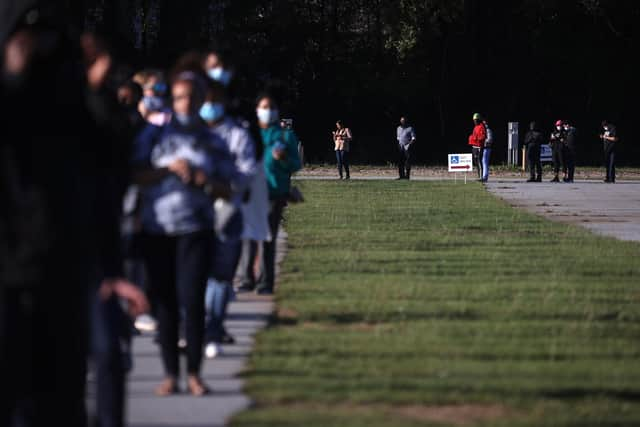Gerrymandering meaning: definition of the term and why it’s hard for many US citizens to vote in the presidential election 2020
The presidential race between Donald Trump and Joe Biden has almost reached its conclusion.
While both candidates have been getting in their last campaign stops in the battleground states those who haven’t already voted will be getting ready to head out to polling booths and cast their ballots.
Advertisement
Hide AdAdvertisement
Hide AdDespite concerns over turnout, US citizens haven’t been dissuaded from voting due to the coronavirus pandemic, as early in-person and mail-in ballot votes placed this year already make up more than half the total vote in 2016.


While the US has a reputation around the world for its love of democracy, some experts say there are a number of issues around its voting system.
Whether it’s the more visible effects of voter suppression, like long queues to vote, or more subtle and systemic issues, like gerrymandering, there are a number of issues which make voting more difficult that it needs to be, or even manipulate the outcome.
Why are lines to vote so long?
In states like New York and Georgia, people have reported extremely long waits for early voting, up to four or five hours and more in some cases, with videos on social media showing long lines to vote snaking down streets and around buildings.
While this has led to free pizza being given out in lines, and even stars like Paul Rudd showing up with cookies, a number of people have highlighted the potential impact this has in terms of voter suppression.
They would argue that having to wait for several hours in line to vote might put people off voting, or make it difficult for those with work or childcare commitments.
Part of the problem this year is the extra time needed to clean voting booths due to the coronavirus pandemic, however, a shortage of booths in some areas has been an issue since long before coronavirus.
A 2020 report by the Brennan Center for Justice titled Waiting to Vote, found that “communities of colour” tend to have to wait longer to vote and that the issue of longer polling station queues correlates with the level of resources in an area.
Advertisement
Hide AdAdvertisement
Hide AdThe report notes that one district in Milwaukee which was “the most diverse city in a largely white state” had seen the number of polling sites reduced from 180 to just five.
What is partisan gerrymandering?
Before people are able to vote in elections, the systems which sort them into voting districts and areas can sometimes be manipulated for political gain, through a practice known as partisan gerrymandering.
Partisan gerrymandering is a way in which a governing party can try to reshape the political map to their advantage
This is done by changing the boundaries of different legislative districts, like constituencies in the UK, in a way that maximises the number of districts the governing party can win.
By creating districts which are disproportionately “packed” with a lot of opposition voters, a governing party can create a number of districts which border this, which will all be easier to win because a large amount of opposition voters have been moved into another boundary.
Areas can also be gerrymandered in the opposite way, when a governing party looks to change boundary lines to break up large pockets of support for the opposition.
According to experts, states like North Carolina, Ohio, Texas and Michigan are among the most gerrymandered in favour of Republicans, while Maryland, Illinois and California are considered to be slanted toward Democrats.
What is the history of gerrymandering?
The practice has long been controversial and in many instances has been challenged in the courts, however the US Supreme Court ruled last year that federal judges have no power to intervene over partisan gerrymandering.
Advertisement
Hide AdAdvertisement
Hide AdThe practice takes its name from Elbridge Gerry, who was governor of Massachusetts in 1812 when a bill was signed allowing his party to draw up the voting districts.
One of the districts as drawn on a map was said to look like a salamander and a cartoonist drew it under the caption “gerry-mander”.